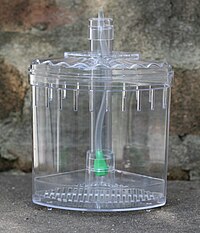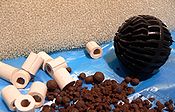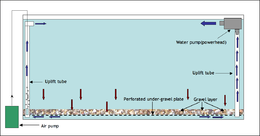Aquarium filter: Difference between revisions
Added quote and reference. I am new at this. |
mNo edit summary |
||
| Line 47: | Line 47: | ||
====Airlift filters==== |
====Airlift filters==== |
||
Sponge filters and corner filters (sometimes called box filters) work by essentially the same mechanism. Both generally work by airlift, using bubbles from an air pump rising in a tube to create flow. In a sponge filter, the inlet may only be covered by a simple open-cell block of foam. A corner filter is slightly more complex. These filters are oftenplaced in the corner on the bottom of the aquarium. Water enters slits in the box, passes through a layer of medium, then exits through the airlift tube to return to the aquarium. These filters tend to only be suitable for small and lightly-stocked aquaria. The sponge filter is especially useful for rearing fry where the sponge prevents the small fish from entering the filter.<ref name=Sanford/> |
Sponge filters and corner filters (sometimes called box filters) work by essentially the same mechanism. Both generally work by [[airlift pump|airlift]], using bubbles from an air pump rising in a tube to create flow. In a sponge filter, the inlet may only be covered by a simple open-cell block of foam. A corner filter is slightly more complex. These filters are oftenplaced in the corner on the bottom of the aquarium. Water enters slits in the box, passes through a layer of medium, then exits through the airlift tube to return to the aquarium. These filters tend to only be suitable for small and lightly-stocked aquaria. The sponge filter is especially useful for rearing fry where the sponge prevents the small fish from entering the filter.<ref name=Sanford/> |
||
====Undergravel filters==== |
====Undergravel filters==== |
||
Revision as of 10:13, 7 January 2008

Aquarium filters are critical components of both freshwater and marine aquaria.[1][2][3] Aquarium filters remove physical and soluble chemical waste products from aquaria simplifying maintenance. Furthermore, aquarium filters are necessary to support life as aquaria are relatively small, closed volumes of water compared to the natural environment of most fish.[4]
In the hi-tech planted tank: "Always choose a filter rated for a larger tank, ideally double or more ie. a 100 l./22 gal. tank should have a filter rated for 200 l./44 gal. This way there is plenty of filter media and maintenance will be easier with the filter remaining cleaner for longer, thus retaining maximum nitrifying efficiency." [5]
Mechanical and biological filtration
The process of mechanical filtration removes particulate material from the water column. This particulate matter may include uneaten food, faeces or plant or algal debris. Mechanical filtration is typically achieved by passing water through materials which act as a sieve, physically trapping the particulate matter.[1] In contrast, biological filtration relies on primarily bacterial decomposition of mainly soluble nitrogenous waste products, such as ammonia (See: Nitrogen cycle management in aquaria. )[2][3]
Materials suitable for aquarium filtration

Numerous materials are suitable as aquarium filtration media. These include synthetic wools, known in the aquarium hobby as filter wool, made of polyethylene terephthalate or nylon. Synthetic sponges or foams, various ceramic and glass and silicon products along with igneous gravels are also used as mechanical filter materials. Materials with a greater surface area provide both mechanical and biological filtration. Some filter materials, such as plastic "bioballs", are best used for biological filtration.
With the notable exception of diatom filters, aquariums filters are rarely purely mechanical in action, as bacteria will colonise most filter materials effecting some degree of biological filtration.[1] Activated carbon and zeolites are also frequently added to aquarium filters. These highly porous materials act as adsorbates binding various chemicals to their large external surfaces[2] and also as sites of bacterial colonisation.
The simplest aquarium filter will usually only have filter wool and activated carbon. The filter wool traps large debris and particles, and the activated carbon absorbs smaller impurities. These should be changed regularly at suitable intervals.[6]
Types of aquarium filters

Numerous types of aquarium filters are commercially available, including:
External filters

External filters remove water from the aquarium which is then pushed (or pulled) through a series of different levels filter media and returned to the aquarium.[1] They are usually more effective and easier to maintain than internal filters.[7]
Canister filters
Compared to filters that hang on the back of the aquarium, canister-style external filters offer a greater quantity of filter materials to be used along with a greater degree of flexibility with respect to filter material choice.[2] Water enters the canister filled with the chosen filter material through an intake pipe at the bottom of the canister, passes through the material, and is pumped back to the aquarium through an electric pump on the top of the canister.[7] A major benefit of this type of filter is that it can be disconnected from the tank for cleaning/maintenance and replaced without disturbing the aquarium. [citation needed] The major disadvantages of canister filters is the increased cost, which is comparatively high compared to other filters, and the relative difficulties in cleaning the long tubes which transfer water to and from the aquarium.[3]
Diatom filters
Diatom filters are used only for sporadic cleaning of tanks, they are not continuously operated on aquariums. These filters utilise diatomaceous earth to create an extremely fine filter down to 1 µm which removes particulate matter from the water column.[1]
Trickle filters
Trickle filters, also known as wet/dry filters are another water filtration systems for marine and freshwater aquariums.[7] This filter comes in two configurations, one which is placed on top of the aquarium (and more rarely seen) and one which is placed below the aquarium (more common).
If the wet/dry filter is placed on top of the aquarium, water is pumped over a number of perforated trays containing filter wool or some other filter material. The water trickles through the trays, keeping the filter wool wet but not completely submerged, allowing oxygen-loving bacteria to breed well and aiding biological filtration. The water returns to the aquarium like rain.[7]
Alternatively, the wet/dry filter may be placed below the tank. In this design, water is fed by gravity to the filter below the aquarium. Once again, it passes through filter wool resting on a perforated plate. After this, the water enters the sump. What is placed in the sump is up to the aquarist. It may contain bioballs, or it may contain a number of compartments, each with its own filtration material. Often, heaters and thermostats are placed in the sump.[7]
Baffle filters

Baffle filters are similar to wet and dry, trickle filters in that they are generally situated below the aquarium. This type of filter consists of a series of baffles that the water must pass through in order to reach the pump which is returning water to the aquarium. These baffles then act, much like a series of canister filters and can be filled with different filter media for different purposes.[8].
Internal filters

Internal filters are, by definition, filters within the confines of the aquarium. These include the sponge filter, variations on the corner filter (pictured top right and left), foam cartridge filter and the undergravel filter.[1] An internal filter may have an electric pump and thus be an internal power filter, often attached to the inside of aquaria via suction cups.
Airlift filters
Sponge filters and corner filters (sometimes called box filters) work by essentially the same mechanism. Both generally work by airlift, using bubbles from an air pump rising in a tube to create flow. In a sponge filter, the inlet may only be covered by a simple open-cell block of foam. A corner filter is slightly more complex. These filters are oftenplaced in the corner on the bottom of the aquarium. Water enters slits in the box, passes through a layer of medium, then exits through the airlift tube to return to the aquarium. These filters tend to only be suitable for small and lightly-stocked aquaria. The sponge filter is especially useful for rearing fry where the sponge prevents the small fish from entering the filter.[7]
Undergravel filters

Undergravel filters consist of a porous plate which is placed beneath the gravel on the base of the aquarium and one, or more, uplift tubes. Historically, undergravel filters have been driven via air displacement. Air stones are placed at the base of uplift tubes which force water out of the uplift tube creating negative pressure beneath the undergravel filter plate. Water then percolates down through the gravel which itself is the filtration material.[1] Greater flow rate of water through the gravel can be achieved via the use of water pump rather than air displacement.[1]
Beneficial bacteria colonize the gravel bed and provide biological filtration, using the substrate of the aquarium itself as a biological filter.[6][7]
Undergravel filters can be detrimental to the health of aquatic plants.[6] Fine substrates such as sand or peat may clog an undergravel filter.[7] Undergravel filters are not effective if the substrate bed is uneven. In an uneven gravel bed, water will flow only through the thin portions of the bed, leaving the more heavily covered areas to become anoxic. Because of this, animals that dig, such as cichlids, are best kept in an aquarium using some other type of filtration.[citation needed]
Submersible pumps/filters
or circulation pumps
Marine-specific systems
Marine aquaria have specialised needs and requirements, to this end the filtration of the marine aquarium is often more complex than freshwater aquariums.
Protein Skimmers
Protein skimmers are filters used to fractionate and remove various organic compounds from marine aquariums prior to their further degradation. The technique uses the chemical polarity of proteins and amino acids to remove the compounds in the foam produced by the filter. Protein skimmers are often used in combination with trickle filters along with various other marine-specific filtration techniques.
Deep sand beds
Deep sand beds filtration is a technique designed to use anaerobic microbes to degrade nitrate to gaseous nitrogen.
Berlin method
The Berlin method of marine tank filtration is similar to the deep sand bed filtration technique in that relies on the action of anaerobic bacteria, in the outer layers of porous rocks, to degrade nitrate to gaseous nitrogen.
See also
References
- ^ a b c d e f g h Riehl, Rüdiger. Editor. (1996. 5th Edn.). Aquarium Atlas. Germany: Tetra Press. ISBN 3-88244-050-3.
{{cite book}}:|first=has generic name (help); Check date values in:|year=(help); Unknown parameter|coauthors=ignored (|author=suggested) (help)CS1 maint: year (link) - ^ a b c d Leibel WS (1993) A fishkeepers guide to South American cichlids. Tetra Press. Belgium pg 12-14.
- ^ a b c Loiselle, Paul V. (1995). The Cichlid Aquarium. Germany: Tetra Press. ISBN 1-56465-146-0.
{{cite book}}: Cite has empty unknown parameter:|coauthors=(help) - ^ Sands D (1994) A fishkeepers guide to Central American cichlids. Tetra Press. Belgium pg 17-19.
- ^ Farmer, George. "The New School." (Published online: Oct. 29, 2007). Pratical Fishkeeping Magazine (UK). http://www.practicalfishkeeping.co.uk/pfk/pages/show_article.php?article_id=625
- ^ a b c Axelrod, Herbert, R. (1996). Exotic Tropical Fishes. T.F.H. Publications. ISBN 0-87666-543-1.
{{cite book}}: CS1 maint: multiple names: authors list (link) - ^ a b c d e f g h Sanford, Gina (1999). Aquarium Owner's Guide. New York: DK Publishing. pp. 164–167. ISBN 0-7894-4614-6.
- ^ Sandford G, Crow R (1991) The Manual of Tank Busters. Tetra Press, USA
